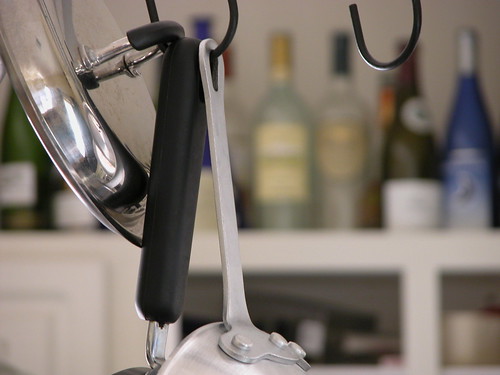
A friend recently went through my blog to see if I had any reviews of cookware, and sadly, my cupboard in that regard was bare. To make up for this deficit, I'd like to add a few thoughts about cookware and how to go about buying it.
Non-Cooking Considerations
I think that all of us who see ourselves as careful chefs would like to say that cooking vessels are purely about optimal function. But, just like food on a plate, the way pots and pans look in the kitchen (since they're not tucked away behind swinging doors with tiny round windows) is important. Picking pots is like picking sneakers, after you've decided on the function, also consider the design. If you hate the way the pot looks, it'll end up at the back of the cabinet.
Sets vs. A La Carte
Sets are great things to put on your registry, but in the end, your pot usage will vary depending on your cooking style. I don't think most sets really give you value over time because you'll end up only using a few pieces consistently.
Form Follows Function
Different sorts of pans do different things well. For example, for braising, you might want to get a Le Creuset dutch oven. Cast iron is ideal for slow cooking and even heat. Le Creuset are well made, last for years, and they're easy to maintain and easy on the eyes thanks to their enamel coatings.
Stainless
For searing, making sauces, and sauteing, you probably want stainless (like all clad). It's non-reactive with acids (like naked aluminum would be) and very durable. It inevitably gets scratched, so don't buy stainless based on a shiny mirror finish. It will soon be gone with regular use.
Since stainless gets very hot and will be filled often with heavy ingredients (like steaks), be sure the handle is easy to manage and comfortable. Any decent pan will have a handle that stays cool. Cheaply made pans have spot-welded handles (you can see the small dimples at the base of the handle) whereas well made pans are riveted.
Another hallmark of a well made pan is a layered base construction. Stainless steel, a metal great for cleanup and durability, is unfortunately a pretty poor heat conductor. That's why fancier pans add layers of aluminum and copper to the inside of their bases to compensate. Some of the pans seems to go overboard with a zillion layers, but it's not all just hokum either. Nothing spreads heat more evenly than copper, which is why many add copper to the mix. If you're going to use an induction cooktop (where an electric field heats up the metal instead of flame), you need to have ferrous metal somewhere in the mix. Pans will be marked whether they're for use on induction cooktops or not.
Non Sticks
I would never advocate getting only non-sticks because they don't develop caramelization as well as bare metal, but they're great for delicate foods like eggs that stick. There are new generations of non-stick that that can stand up to metal utensils and being washed in the dishwasher. The key to non-sticks is not to overheat them: the coating breaks down and throws off hazardous gasses when heated to temperatures over 500 degrees, so don't leave them on the heat without food in them or use them in the oven.

good, great, grand, wonderful! i'm digging the more frequent posts and always have an eye out for any new ones.
ReplyDeletei'll have to keep these thoughts in mind when i go to register for my wedding!